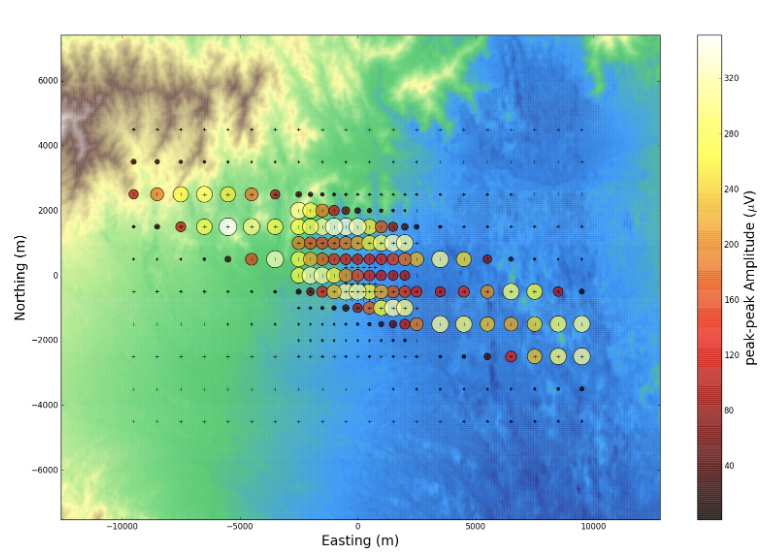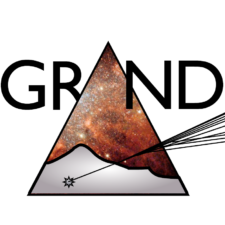The GRANDProto300 detector (2023-) is a prototype of GRAND that will be comprised of 300 radio antennas. Since February 2023, members of the GRAND collaboration are deploying antennas in the desert of XiaoDushan, Dunhuang, China.
The goal of GRANDProto300 is to validate the detection principle of near-horizontal extensive air showers (EAS). To do so, GRANDProto300 will demonstrate the detectability of EAS using a standalone radio array with high efficiency, and a rejection of background transient events close to 100%.
GRANDProto300 will also enable to explore a rich science case: the cosmic-ray “transition region”, ultra-high energy gamma rays, and on the side of radio astronomy giant pulses, fast radio bursts, and the 21-cm line from the epoch of reionization.
The GRANDProto300 detector
Build an autonomous radio detector!
GRANDProto300 will be comprised of about 300 antennas, deployed over 200 km 2. It will operate in the 50-200 MHz band and will trigger on nearly horizontal air showers.
Using radio signals alone, GRANDProto300 will separate the signal from the background. Moreover, it will reconstruct the properties of the primary particles with a precision rivaling standard cosmic-ray detection techniques.
Demonstrating that autonomous radio detection can succeed is an exciting challenge. GRANDProto300 should be in the best situation to undertake in this challenge, with its electronics capable of treating signals at high frequency rates, and its exceptionally radio quiet environment.
A hierarchical density array
The preliminary layout of GRANDProto300 covers 200 km 2 with ~200 detection units. A sparse array is complemented by a denser infill. The density hierarchy enables to reach good accuracy and large statistics in the energy range 10 16.5 – 10 18.5 eV. Dedicated simulations will define the exact layout of GP300, by taking into account the physical properties of the selected site.

Experimental Setup
The HorizonAntenna is part of every detection units. SUBATECH Nantes conceived this bow-tie antenna, inspired by the butterfly antenna developed for CODALEMA and used for AERA. The antenna sensitivity is optimal in the 50-200 MHz frequency range. This frequency range optimizes the signal-to-noise ratio, minimizes the effect of ground diffraction at the lowest frequencies, and detects the Cherenkov cone at the highest frequencies.
Radboud University in Nijmegen designed the Data Acquisition systems (DAQ). It performs the filtering, digitizing and processing of the antenna signal at the antenna level. Communication and data transmission will use WiFi technology. The maximal power consumption of one detection unit is 8 W, with an average power consumption of 3 W. The 100 W solar panels guarantee a 100% duty cycle.
Performances of GRANDProto300
The exposure of GRANDProto300 was calculated using a realistic topography, and with simulated trajectories of 5 million air showers.
The simulations cover all azimuth, zenith angles between 45 and 89.9º and energies between 10 and 10 3 PeV. In order to identify signals (versus noise), a minimum of 5 antennas with a signal 5 times above the mean stationary noise was considered.
This study shows that GRANDProto300 could detect up to 10 6 ultra-high energy cosmic-ray events during its first year of operation, which constitutes a significant statistics in this energy range.
More simulations will assess the reconstruction performances of GRANDProto300. They will improve the determination of the nature of the particle producing the air shower, its arrival direction, and energy.

A rich Science Case
The cosmic-ray transition region
Cosmic rays at energies 10 16.5-18.5 eV belong the the so-called “transition region” of the cosmic-ray spectrum. In this energy range, their production sites are believed to transition from Galactic to extragalactic sources.
Several mysteries concerning this transition puzzle the scientists, such as:
- the identification of the Galactic cosmic-ray sources above ~ 10 15 eV,
- the maximum energy and the composition of cosmic rays produced in the Galaxy,
- the identification of the extragalactic cosmic-ray sources at the highest energies.
Answering these complex questions require from experiments:
- an enhanced statistics of cosmic-ray detections,
- an improved reconstruction of the energy and composition of cosmic rays,
- an improved reconstruction of their arrival directions.
GRANDProto300 is therefore well equiped to tackle these issues
Ultra-high-energy gamma rays
As cosmic rays, energetic gamma rays interact with the atmosphere and create air showers. The detection of ultra-high energy gamma rays would give crucial information about cosmic-ray accelerators in the local Universe.
GRANDProto300 will be able to distinguish between air showers induced by ultra-high energy cosmic rays and gamma rays. Current methods are statistical, and other methods are being developed by the GRAND collaboration. Reconstruction methods recenly developed show promising results in terms of arrival direction, energy and primary composition reconstruction.
Radio-astronomy
Short radio pulses
While being unchallenged on the field of high sensitivity observations, standard radio-astronomy is pushed in its corner when it comes to fast radio transient astronomy. Indeed, because of the antenna phasing, the effective field of view is proportionally reduced to the sensitivity increase. Therefore, being able to be at the right place and at the right time to catch milliseconds (and even shorter) radio pulses becomes a real challenge.
GRANDProto300 can overcome this difficulties by monitoring the whole sky at once, thanks to its un-phased array and large number of antennas. By doing so, it will provide an unprecedented survey over the full sky of these new fast radio transients, such as the so-called fast radio bursts and giant radio pulses.
Such study could answer the questions of the true rate of this event in the Universe with a much better precision than standard radio-telescope. Furthermore, the field of fast radio transients is new and only exists because of recent improvement in time resolution and fast acquisition of radio-telescope, in these conditions, who knows the possible extent of this field and what other type of fast radio transients can lie out there.
Transient radio signals will be detectable with GRANDProto300, by performing temporal sums of incoherent Fourier transforms from all the antennas. The large number of antennas in GRANDProto300 makes it a competitive instrument with respect to phased arrays. The field of view of GRANDProto300 will enable full-sky surveys of giant radio pulses and fast radio bursts.
Epoch of reionization
Moreover, with sufficient precision on the antenna calibration, GRANDProto300 could measure the temperature of the sky with a mK precision. It could complement recent measurements of the 21-cm line from the epoch of reionization (EoR). The Cosmic Microwave Background (CMB) contains this line-like absorption feature, redshifted to frequencies between 10 − 200 MHz. The current measurements of this signal differ from theoretical predictions. GRANDProto300 could therefore improve the determination of this feature characteristics.

